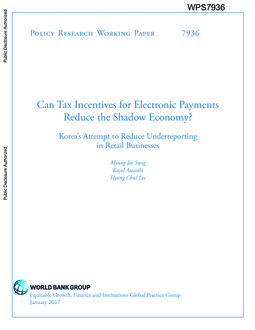Hello! You're looking at a policy document report on Overton
We track government policy, guidelines, think tank research, working papers and more to help our customers see the impact and influence of their work. Are you interested in seeing what information we have to offer? Request a free trial to our platform.
If you fund, produce or manage research or work to influence policy, we'd love to talk. Learn more on our homepage.

Identifiers
handle
10986/25945
Can Tax Incentives for Electronic Payments Reduce the Shadow Economy? : Korea's Attempt to Reduce Underreporting in Retail Businesses
Awasthi, Rajul, Sung, Myung Jae and Lee, Hyung Chul
Increasing tax revenues by reducing the shadow economy has been a central goal of tax policy and administration in the Republic of Korea since the National Tax Service was established as an independent agency in 1966. This paper examines the Tax Incentive for Electronically Traceable Payments, which was introduced by the Korean tax authorities in 1999 to promote payments made using credit cards, debit cards, and electronic cash receipts in business-to-consumer transactions. The tax incentive allows wage and salary earners to claim tax deductions for eligible purchases made using electronically traceable payments when they file their year-end income tax settlements. The tax incentive scheme greatly contributed to changing the Korean economy into a cashless economy over the past decade and a half. Card payments as a ratio of Korea's gross domestic product have ranked the highest in the world since 2005, reaching 49 percent in 2014. The Tax Incentive for Electronically Traceable Payments scheme has changed th...
Topics in this document
Finance
Services (economics)
Business
Payments
Economy
Cheque
Tax refund
Financial transaction
Black market
Invoice
Debit card
Payment
Receipt
Credit card
Value-added tax
Tax
Subsidy
Tax credit
Money
Bank
Point of sale
Tax deduction
Income tax
Informal sector
Sales
Market (economics)
Revenue
Employment
Progressive tax
Human activities
Citations
Cited by 16
other policy documents
(6 of them are from other policy sources)
